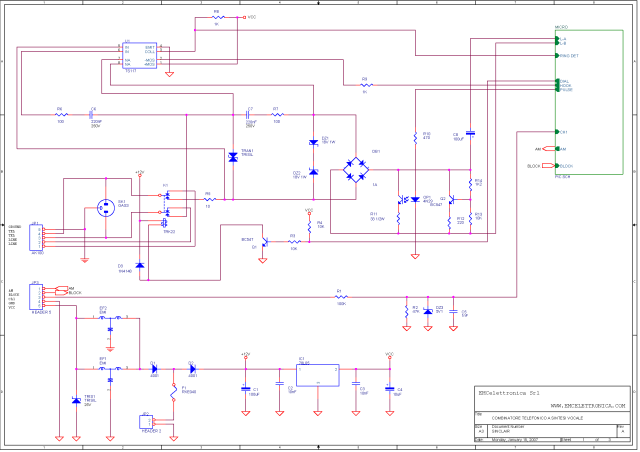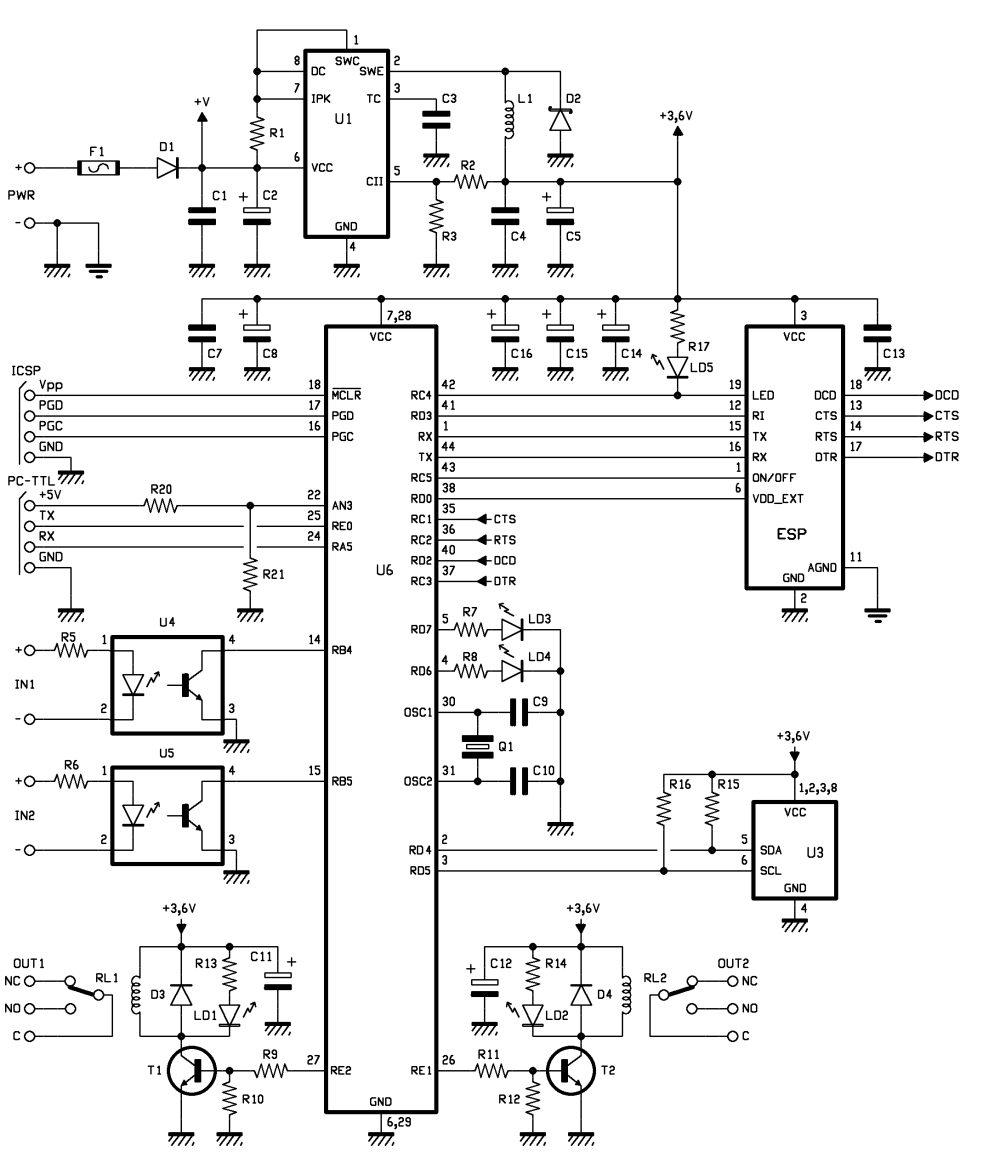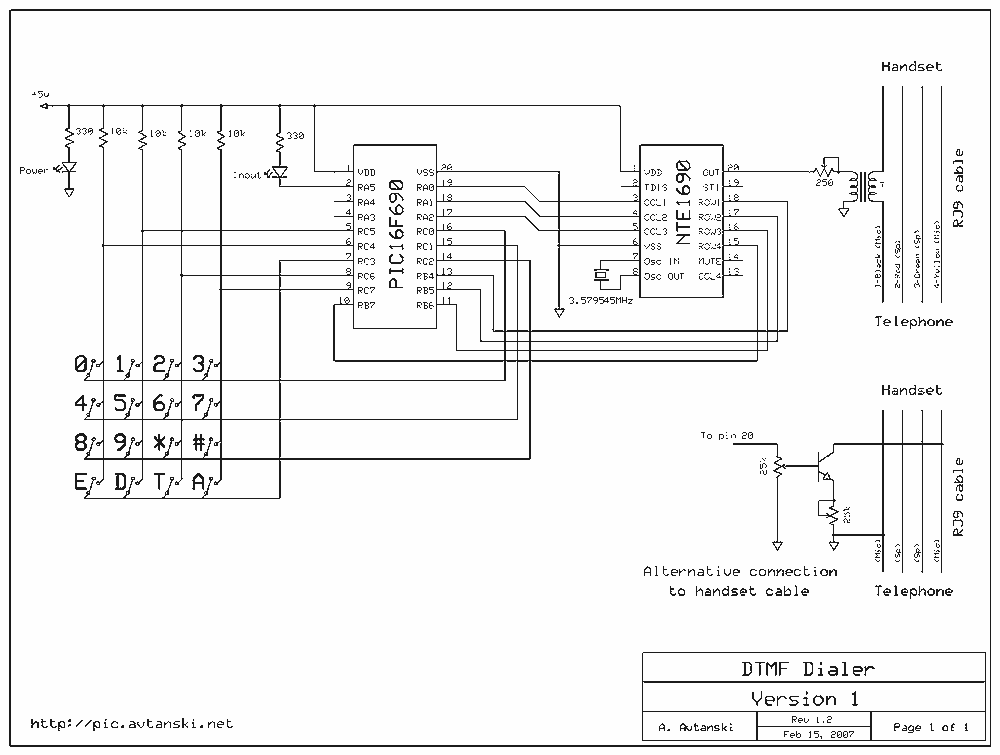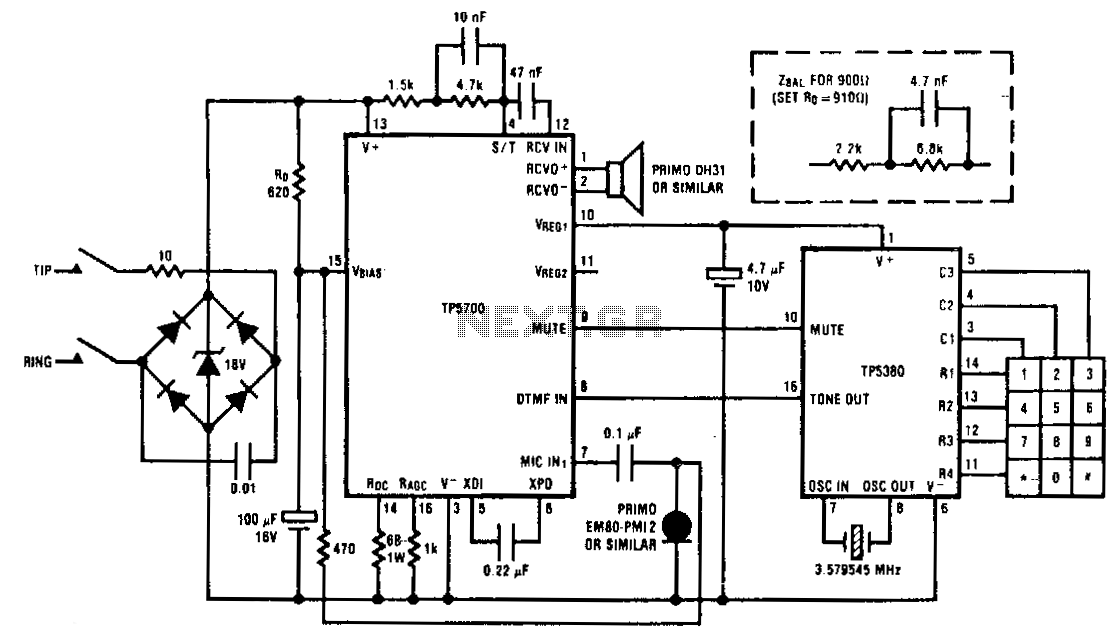
DIAL ALARM-1
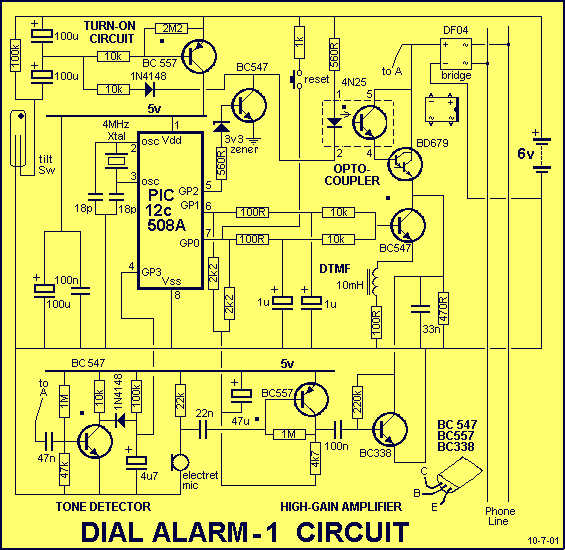
This is the lowest cost dialing alarm on the market and shows what can be done with an 8-pin microcontroller. The complete circuit is shown below. You cannot see all the features of this project by looking at the circuit - most of them are contained in the program. So, read on and see what we have included. Dial Alarm-1 has a single input (although a number of sensors can be placed in parallel on the same input line). The circuit requires a trigger pulse to turn on a BC 557 transistor. This delivers power to the microcontroller. The micro starts to execute the program and outputs a high on GP2 to keep the "turn-on" circuit active. It also turns on the LED in the opto-coupler and this causes the line to be "picked up" via a high-gain Darlington transistor. The micro then dials two phone numbers and executes a series of events to alert the called party of an intrusion.
The dialing alarm circuit utilizes an 8-pin microcontroller, which serves as the core processing unit for managing the alarm system's operations. The circuit's architecture is designed to be cost-effective while providing essential functionalities for security applications.
At the heart of the circuit is the BC557 PNP transistor, which acts as a switch. When a trigger pulse is applied to the base of the BC557, it conducts and supplies power to the microcontroller. This initial activation is crucial as it allows the microcontroller to begin executing its programmed instructions. The microcontroller's GPIO pin GP2 is configured to output a high signal, which maintains the power to the "turn-on" circuit, ensuring that the alarm system remains active during its operation.
An opto-coupler is integrated into the circuit to provide electrical isolation between the low-voltage microcontroller and the high-voltage telephone line. When the microcontroller activates the opto-coupler's LED, it triggers a corresponding phototransistor, which in turn engages a high-gain Darlington transistor. This configuration is essential for ensuring that the telephone line is "picked up," allowing the dialing process to commence.
Once the line is established, the microcontroller is programmed to dial two pre-defined phone numbers. This functionality is critical for alerting the called party in the event of an intrusion. The program may also include various alerts or messages that can be communicated through the phone line, providing the recipient with information regarding the nature of the alarm.
The design accommodates multiple sensors that can be connected in parallel to the single input line. This flexibility allows for various detection mechanisms, such as motion sensors or door/window contacts, to be integrated into the system. The overall circuit design emphasizes efficiency and reliability, making it suitable for a wide range of security applications while maintaining a low cost.This is the lowest cost dialing alarm on the market and shows what can be done with an 8-pin microcontroller. The complete circuit is shown below. You cannot see all the features of this project by looking at the circuit - most of them are contained in the program.
So, read on and see what we have included. Dial Alarm-1 has a single input (although a number of sensors can be placed in parallel on the same input line). The circuit requires a trigger pulse to turn on a BC 557 transistor. This delivers power to the microcontroller. The micro starts to execute the program and outputs a high on GP2 to keep the "turn-on" circuit active.
It also turns on the LED in the opto-coupler and this causes the line to be "picked up" via a high-gain Darlington transistor. The micro then dials two phone numbers and executes a series of events to alert the called party of an intrusion.
🔗 External reference
The dialing alarm circuit utilizes an 8-pin microcontroller, which serves as the core processing unit for managing the alarm system's operations. The circuit's architecture is designed to be cost-effective while providing essential functionalities for security applications.
At the heart of the circuit is the BC557 PNP transistor, which acts as a switch. When a trigger pulse is applied to the base of the BC557, it conducts and supplies power to the microcontroller. This initial activation is crucial as it allows the microcontroller to begin executing its programmed instructions. The microcontroller's GPIO pin GP2 is configured to output a high signal, which maintains the power to the "turn-on" circuit, ensuring that the alarm system remains active during its operation.
An opto-coupler is integrated into the circuit to provide electrical isolation between the low-voltage microcontroller and the high-voltage telephone line. When the microcontroller activates the opto-coupler's LED, it triggers a corresponding phototransistor, which in turn engages a high-gain Darlington transistor. This configuration is essential for ensuring that the telephone line is "picked up," allowing the dialing process to commence.
Once the line is established, the microcontroller is programmed to dial two pre-defined phone numbers. This functionality is critical for alerting the called party in the event of an intrusion. The program may also include various alerts or messages that can be communicated through the phone line, providing the recipient with information regarding the nature of the alarm.
The design accommodates multiple sensors that can be connected in parallel to the single input line. This flexibility allows for various detection mechanisms, such as motion sensors or door/window contacts, to be integrated into the system. The overall circuit design emphasizes efficiency and reliability, making it suitable for a wide range of security applications while maintaining a low cost.This is the lowest cost dialing alarm on the market and shows what can be done with an 8-pin microcontroller. The complete circuit is shown below. You cannot see all the features of this project by looking at the circuit - most of them are contained in the program.
So, read on and see what we have included. Dial Alarm-1 has a single input (although a number of sensors can be placed in parallel on the same input line). The circuit requires a trigger pulse to turn on a BC 557 transistor. This delivers power to the microcontroller. The micro starts to execute the program and outputs a high on GP2 to keep the "turn-on" circuit active.
It also turns on the LED in the opto-coupler and this causes the line to be "picked up" via a high-gain Darlington transistor. The micro then dials two phone numbers and executes a series of events to alert the called party of an intrusion.
🔗 External reference

